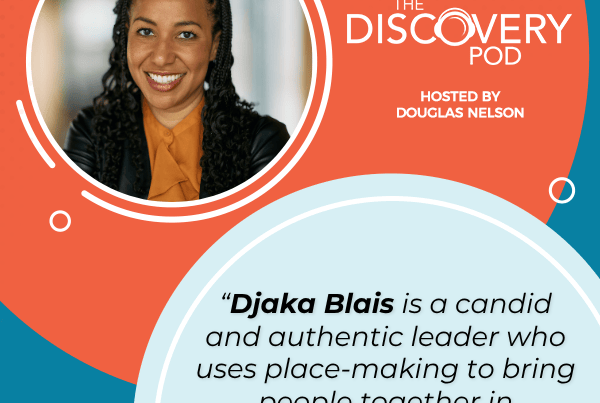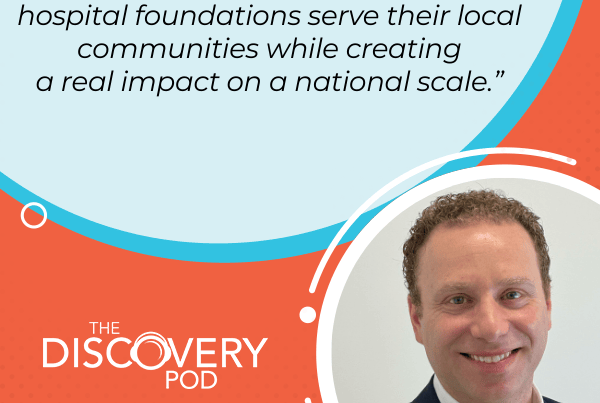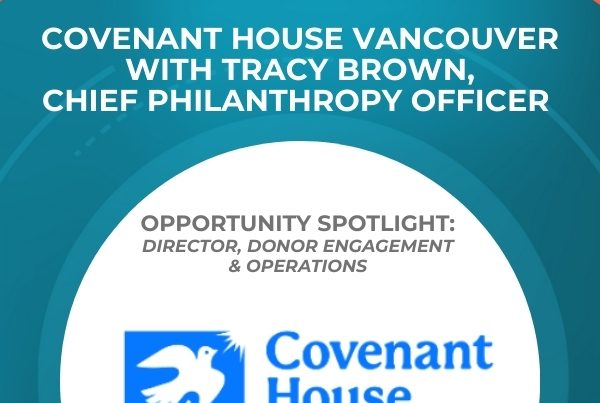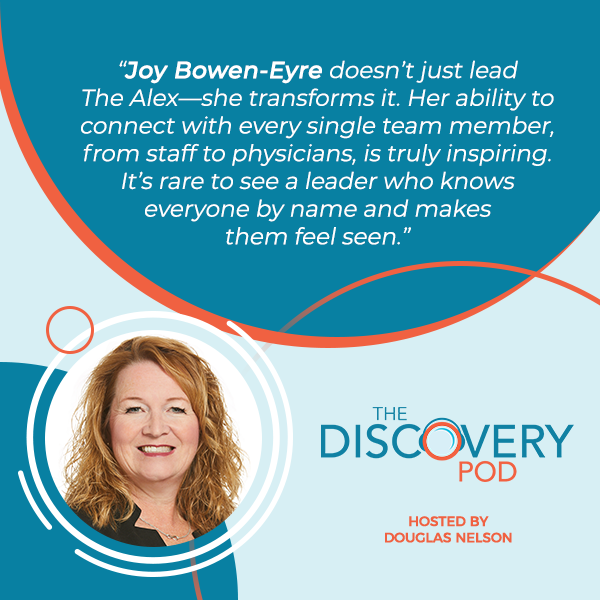
Douglas Nelson speaks with Joy Bowen-Eyre, CEO of the Alex Community Health Centre in Calgary, Alberta. The conversation centers on Community Health and Joy’s insights into leadership, collaboration, and the importance of serving Calgary’s most vulnerable populations. Joy shares the inspiring story of how Alex provides essential health, housing, and social services to over 15,000 individuals each year, while discussing the power of partnerships and servant leadership. Tune in to hear how Joy’s approach is transforming lives and communities.
—
Listen to the podcast here
The Alex Community Health Centre With Joy Bowen-Eyre, Chief Executive Officer
Welcome to the show, conversations with social profit leaders. In this episode, we have Joy Bowen-Eyre. She is the CEO of The Alex Community Health Center in Calgary, Alberta. The Alex is one of the best-kept secrets in Calgary. You’ll hear her talk about that. That serves more than 15,000 of Calgary’s most vulnerable citizens each year. The organization does exceptional work and she talks a little bit about that. What I think you as readers are going to enjoy most, so she talks about servant leadership, knowing everyone who works in the building, and what it means for what that team is able to accomplish. Her definition of working in partnership and learning from mistakes is something all of us as leaders can learn from. I hope you’ll enjoy this conversation with Joy Bowen-Eyre. Thank you for reading.
—
Welcome to the podcast, Joy.
Thank you, Doug. good to join you on a Friday afternoon.
Why is it a great day? Of course, it’s the fall here in Vancouver. It’s raining like crazy. Probably not the same in Calgary.
We’ve had a little bit of sun here. It’s nice. We still have leaves on the trees, which is very unique for Calgary at this time of the year. Usually, we have a big wind gust and they’re all gone within a day or two. It’s nice here.
It wouldn’t be a Canadian show if we didn’t start talking about the weather. I think it’s good for us. I want to jump really quickly into the great work that you and your colleagues do there at The Alex, one of the most sophisticated and significant organizations that maybe not enough people have heard of. Tell us about your organization and who you serve.
Introduction And Overview Of The Alex
I’m really glad you started with that and we don’t like this and we really need to change this. This opportunity to talk about what we do and how we do it is excellent. We often say that we’re one of Calgary’s best-kept secrets and so that does need to change. We are a community health center. For the folks who are listening, a community health center is a blend of primary healthcare services. Healthcare with a family doctor combined with social services.
We serve the underserved population or marginalized community, vulnerable Calgarians. People who have difficulty accessing services are the type of folks that we serve every day. We do it in three big pillars. We offer health, we offer housing, and we offer social services support. It’s an exciting place to be. We’ve been in operation for 51 years serving Calgary’s community. Every day we serve hundreds of Calgarians.
Joy, in my work with organizations, I hear not quite every day, but very frequently organizations saying we’re the best kept secret, where nobody knows about us. In your case, I think it’s really true. When I had the chance to tour your facilities, I was just struck by just the sheer scale of the operations, the services you provide, and the people that you’re helping and supporting on a daily basis. How is it that an organization that does as much as The Alex comes to be that best-kept secret? Where have you been hiding yourselves?
I think sometimes we might like being Calgary’s best-kept secret. Intentionally, we haven’t done a lot of branding and marketing. Part of the reason why is, as you know in Canada right now is getting access to a primary healthcare physician is really hard. If we were to actually advertise, I don’t think I actually am confident that we couldn’t keep up with the demand. I think once folks stepped in our doors and saw that integration of the care that we offer, that team-based care, they’d want that.
Some of the things that we have talked to government and funders and community-minded people about is if everybody can’t get access to the care that we provide, then the folks that should get access are those who are vulnerable. That best-kept secret is if you know about us, you tend to really like what we do. You like the model of care, and you want to be an ambassador for us. Part of our goal is trying to get as many people through our doors to showcase what we do and how we do it.
First and foremost, Doug, what I would have to say is, we probably have the best staff team in all of Calgary and the best doctors. Physicians choose to come work here at The Alex with very complex folks. I think that speaks to their character and to their commitment to making the community a better place. That’s the same as our staff. They could work many places, but they choose to work here at The Alex, trying to make the lives of Calgarians better each and every day.
It certainly has a very special feel. One of the challenges we see a lot of organizations trying to make peace with or understand is that serving particularly serving vulnerable populations. There are specific services that they’re designed to deliver. They’re funded primarily or initially to provide. There are all the adjacent needs that come with serving the vulnerable populations. That can end up in scope creep or stretching those grant dollars a little further than they actually can cover. How do you approach providing everything, providing as much as the vulnerable populations that you serve need with that focus on being a primary health center?
I think one of the things that we do really good at is we partner with other organizations. If we cannot offer the service, but we know that the service will be good for the folks that we serve, we invite others to come into our space. For example, we partner with school districts to take our mobile healthcare services there. We partner with the Calgary Drop-in, with the Dream Center, with Source, with other organizations and take our healthcare services directly to them.
The best way to say that is we meet people where they’re at. We go to where folks are, we don’t force everybody to come directly to us. I think when we know that we can offer a specific service, we partner with somebody. We’ve got our friends across the street, our momentum, and they offer phenomenal services around training, the trades, and financial empowerment. Why would we offer that service when we know our colleagues across the street can do a better job than us? We invite them into our space.
We meet people where they're at. We go to where folks are; we don’t force everyone to come to us. Share on XThat collaboration and partnership are very big concepts in the social profit sector, lots of organizations talking about it, and more boards saying, “Why aren’t we doing more of that.” Donors say, “We want to see organizations working together.” You do that on a daily basis. What are the hallmarks of really effective partnerships that you see in your role at Alex?
Building Effective Partnerships In Social Health
I think one of the biggest things is trust and understanding of what our role is and what a partner’s role is. Quite often because we offer healthcare where others don’t. Our ability to define what it is that our team does and what somebody else’s team does is a bit clearer than other not-for-profit organizations. I think it’s that trust, that commitment to continuously providing services. I know for the two big school boards in town, they love the fact that our dental health bus goes to schools in areas identified where families and young people don’t typically access dental care.

Community Health: Trust is the biggest key in building effective partnerships. It’s the commitment to continuously provide services.
The school districts are calling us long before schools go back in September to say, “Which schools are you going to? When is the bus rolling out?” Principals and teachers call us directly and say, “Is your bus coming to our schools this school year?” That ability to build those relationships with our partners is critical because then it’s that they know that we are coming or committed and that we will work together. We take the ego out of things, and I think that’s really important.
I think that taking the ego out is easier to say than do for all of us as human beings, but certainly in our sector. In that example you just gave about the dental bus, the temptation might be in another organization, there’s such a demand. We need a 2nd and a 3rd or a 4th or a 5th bus, and we need to do every school every year. How do you maintain that focus around ensuring these vital pieces stay pieces of this larger puzzle?
Part of that is working directly with the schools and with Alberta Health Services to identify which of the schools are most in need. Having a one-size-fits-all approach when dollars are scarce, I don’t think serves as well. We have very intentionally focused on the schools and the areas that need our services the most. Where sometimes a school will call us and say, “Can you come visit us?” Instead of just responding quickly and dashing out there, we’ll go into the district and say, “We heard from this school and they want us to come visit. Do you think is that the right place?” They’ll pull data. We’ll help look to the data to help us guide our decision-making. I think that’s really important.
I think that’s an excellent point. One of the other things I wanted to ask you about, you’re as a social profit, of course, you’ve got a board, a volunteer board of directors. When you say healthcare is a simple mandate, of course, there’s nothing simple about healthcare in our Canadian context. How, as CEO, do you approach ensuring your board understands the operating model, and the business that Alex is in, well enough to do their job well?
We embarked on a different way of recruiting board members most recently, and so we actually used a search firm to assist. What we did is we screened for people who had a commitment, who shared our values, so had common values to The Alex, no different than when we recruited for staff. We want staff values to align very closely with the organizational values because we know that that becomes a fit. We did the exact same thing with our board members. The other thing we did this year was we did a very robust onboarding. We spent a full day with all of our board members. We toured them around our sites, our housing site, and our community food center.
We went to our seniors health center, our main site, and we toured them around the buses. We sat down and talked about what our vision is, what our mission is, what our purpose is, who we serve and how we serve, and more importantly, how we’re funded. That robust onboarding was really helpful. Newer board members said to us, “This is the first time that we have been on a board and been onboarded to an organization with such a robust process.” It really helped them understand the what and the why.
For those new board members coming in, the value aligns with some experience in the space. What were their initial reactions when they were exposed to the work of the organization?
I think like many new board members, what they’ve done is they’ve looked at our website, but the website doesn’t tell the whole story. They needed to come into our space and have conversations with staff, have conversations with patients and clients and really get to understand how the work was being done. I think this was a real game-changer for many of our board members. They left that day and their comments were that they were in awe. They were absolutely amazed by what our team was able to do each and every day. They left with a sense of renewed purpose about why The Alex exists.
I think that sense of purpose means so much when you’re working with a board, the details, the operational details where you don’t want your board hanging out too much or spending too much time on the fine details of the operations. If there is that alignment around purpose, like what our organization shows up every day to do, the change we seek to make in the world, it counts for a lot and it covers a lot of bumps along the way. How do you make sure that purpose stays front and center for your board?
We embarked on a new strategic planning process in the middle of the pandemic, which was certainly interesting to mark on that process in the middle of the pandemic. We have been laser-focused as a board and as an executive and the rest of our organization about focusing on what our five key strategic priorities were. We have aligned all of our board meetings to cover the five strategic priorities.
That has really helped the board to understand where we’re going and how we need to get there. We’ve done that internally as well. Staff meetings, leadership meetings, town hall meetings. I think it’s really helped everybody point towards the same North Star. I think in not-for-profits, sometimes you can get multiple different stars going on in the universe. With lots of people with lots of different passions. How do you get everybody working towards the same North Star? That’s something that we’ve been striving for in the last three years.
It certainly seems to be working, given all that’s going on at your organization what you’ve got planned. You mentioned your location. We don’t usually break news here on the show, but maybe we can do that a little bit. Tell us a little bit about the process you’re underway about acquiring your own building.
We have been on this site for seven years, and we have embarked on a long-term lease. At the time, they had wanted to bring all of The Alex together. From a sustainability perspective, from a not-for-profit, from creating a home, we talk about creating a medical home for patients. We here at The Alex want to create a home for our organization. We have been working really hard behind the scenes to purchase our main site-building.
We’re getting really close to being able to close that deal. It’s a very exciting time for all of us at The Alex, whether that be a board member, a frontline staff, or even our physicians are very excited about this prospect because it’ll allow us to put deep roots into the community. It will allow us to be sustainable long-term and it will allow us to let folks know that we’re here and we’re here to stay and we’re here to provide services and care to vulnerable people.
Just with a stroke of a pen, you just make that decision.
No bigs, Doug. It’s been in the works for many years and I would like to give credit and thanks to everybody who’s been along the journey with us to make that happen. It’s something that I think will serve the Calgary community well by The Alex having a permanent home.
Again, I keep coming back to the uniqueness of your organization, and I want to ask one more question about that. One more, if you’ll allow me. I’m thinking about the important role that philanthropy can and will play in the future of the organization. You have a health care mandate, you’re providing that primary care. To a large extent, a social service component is associated with that as it relates to the vulnerable individuals that you support and provide care for. As CEO and with all the partnerships you’re working with, with the government, with AHS, Alberta Health Services, how do you communicate that value of that in-between space that The Alex occupies that so few organizations do?
Philanthropy And Healthcare For Vulnerable Populations
I think actually that’s the uniqueness and the magic mix of The Alex and I think governments they like it when corporate Calgary, when philanthropy is part of your makeup and part of your model. We’re able to demonstrate firsthand that. We have a number of significant partnerships with major donors and major organizations. Our whole mobile fleet, four buses, is all funded by generous Calgarians or generous organizations. That’s something that others don’t do. We have benefited from the generosity of philanthropy and community impact dollars from big corporations because they see the value that providing healthcare to vulnerable people can have.
When we have conversations with governments about our primary healthcare services, they understand that the government serves vulnerable populations. They understand that it’s the government’s role to provide public healthcare but they also appreciate that the community wants to be a part of that and they want to be a part of that journey. It works really well. Now, don’t get me wrong, my CFO has to be an absolute magician about putting all this funding together. I so appreciate her, Susan Simpson. I think that’s what makes it a beautiful thing.
When you think about the concept of a community health center, we’re already signaling to the community and to government and to philanthropy that it’s the community who comes together to make our health center work. We don’t want to be 100% funded by the government. We like the autonomy that we don’t fall under like Alberta Health Services, for example, of being able to say, we’ve listened to the community. We’ve had conversations with the community and the community is telling us that these are the kinds of services that need to happen for their neighbors.
Philanthropy and community work together to make our health center thrive. Share on XIt’s because of really good relationships with our neighbors. Where The Alex is located, I feel very blessed and I’m going to do a shout-out to Spartan and Stantec. They’re our neighbors, they literally are across the street from us. Every month, Spartan and Stantec, not only do they donate to us, but they also send volunteers from their workforce to come and help us on-site by helping deliver community meals to our vulnerable Calgarians. We’ve built a community even within our own community. I think that’s really powerful.
That is very powerful. I think when we think about what’s the secret to unlocking philanthropy as an even greater force within the organization, it’s something that I know you or on your leadership table are talking about. From my perspective, it’s just getting people into your space, getting people into that center is going to be like a magic wand when it comes to philanthropy to see the connection.
One of the things that really jumped out was, first of all, not only did everyone know your name, and say it with a smile on their face but you knew everyone else’s name. Walking through that. There’s a real sense of culture and community within the organization. That’s not always the case in social serving organizations. What is your approach as a leader to create that or to support that going forward? In my experience, that culture doesn’t just happen on its own.
Servant Leadership And Engaging With Staff
This one’s harder to talk about because this is more about me. One of my superpowers, Doug, is I remember people’s names. I remember names and I remember faces. What I do know about leadership is your name matters. Being seen matters. Being acknowledged for the work that you do matters. I spend a lot of time with our staff. I call it, my EA will be the first to tell you, my lovely Doug, his name’s also Doug. Being Doug must be a good thing. I call it leadership by wandering around.
Being seen matters. Being acknowledged for the work you do matters. Share on XWhen I connect with our staff teams, and so I just did two tours here today. I did another big tour yesterday. I get to know our staff. I get to know their name, who they are, what makes them tick, and why they chose to come here. I want to know about them personally because if I get to know them personally, I can understand their why. Their passion and their reason for being. I think part of that is they start to then recognize that they’re not just a number here at The Alex. They’re a critical member of our staff team. That really the magic that happens here at The Alex can’t be done by just one person. It takes all of us.
Everybody who chooses to come here comes because they have a story. They choose to come here because they’ve either experienced trauma themselves, or they want to make a difference for people less fortunate than them. They come here because they have a calling. Knowing the staff, getting to understand their work. I shouldn’t be too proud to help out and serve a meal. It shouldn’t be beyond me to stop and serve somebody some coffee. It shouldn’t be beyond me to help somebody in our lobby. If we’re truly a community health center, that means everybody digs in, pitches in, and helps out.

Community Health: Everyone who chooses to come here has a story. They have a calling to make a difference.
One thing I can tell all of our readers, I can answer a question they probably haven’t asked themselves, but how many long hallways and stairwells are there at The Alex? The answer is there are a lot of them. Just to back up and put more spotlight on you than you’re probably comfortable with, we were walking down a long hallway and came to a stairwell. We went through the door, and there was a woman there facilities maintenance, doing her work. What struck me was she immediately stopped what she was doing and took a pause of going about what she was going to be in conversation.
She didn’t hesitate. She didn’t wait for you to say hello. She turned, you knew her name, she knew your name, and you had a brief conversation, but she knew that what was going to happen was that the CEO was going to stop in this random stairwell where she was doing her job, and that was perfectly normal for the two of you, and then we just went on. I thought that was such a remarkable, quiet example of engaged leadership and servant leadership. Sometimes phrases that we use a lot in our sector. For me, and I think back over the last year or so, that is one of the most vibrant examples of what it looks like for a leader to be in service to their organization and on the same team as their team.
We run a healthcare facility. If our facility is not clean, that is a huge risk to our organization. Our facility staff are key members of our team. We have chosen to pay all of our staff at minimum Alberta’s living wage. We have signaled to our facility staff the importance of their work. They see themselves as part of the whole organization. We could not practice medicine without the facilities team.
I think that’s the part that they’re not just somebody from facilities. They’re like, there’s somebody from facilities and this is an important job. I appreciate how clean they ensure, like it’s like people walk in our building and they assume that because we’re serving vulnerable people the place is dirty. That’s one of the first things that they marvel is what a clean and immaculate place it is. I’m proud of that. I’ll be the first to say that it’s because of our amazing facilities team.
The body language that she demonstrated when she encountered you as the CEO was no different than the physicians when they encountered you as the CEO. Glad to see you. Everybody’s busy, so it was a short, brief conversation. You were exactly the same to whoever we talked to as we went through that building. It was really remarkable. It’s just a good reminder to our readers, and particularly our readers who are reading to get tips on how to become a leader, and how to become a CEO. What does it mean to show up as a servant leader and that effortless transition to talk to everybody exactly the same within the organization was just really remarkable? I thought it was really special, Joy. It felt like that was as much a privilege as getting to see the building.
Thank you. I work hard each and every day to be my best self when I’m in the building.
It’s not easy. You have this big job, lots of people, lots of people depend on you, both within the organization, the people you serve, and all of your partners. When you’re having a challenging day or there’s an issue that hasn’t gone quite your way, we’ll say it hasn’t gone your way yet. Who do you call for advice or just say, “You got to listen to this?”
I have got a number of different colleagues in our sector that I rely on heavily, fantastic, smart leaders. I’ll list a few of them off and I want to make sure that I do. Sandra Clarkson from the drop-in is on speed dial and will always pick up the phone to me and we help strategically problem-solve one another. Another person that I have great respect for, is Jeff Dyer, who is with Trellis, and has tremendous respect for him. Shannon Durham from the YMCA, is an amazing human, a great leader. I don’t want to be careful so I don’t miss anybody. Sue Tomney from the YWCA, is another great, fantastic human.
Robyn Romano from the Distress Center. If I’m having a hard time, I know that I’m not alone and I’m hopeful that one of these colleagues that I’ve mentioned has either walked that path before me, has experienced what I’ve experienced, or if they haven’t, they can share some tips, or at least help de escalate me. If all else fails, Doug, McDonald’s is about a seven-minute drive, and I am known to do, like leave the building in my car, whip up and get like a junior McChicken with small fries and a Diet Coke, starve myself out, eat that, come back, reset myself and come into the building and ready to rock.
I think you’re not alone. A lot of leaders’ feelings get very hungry sometimes.
It’s my guilty pleasure. That’s the only thing I eat at McDonald’s is the junior McChicken. Love it. It’s my guilty pleasure. It really helps reset me. It’s probably not good for my cholesterol levels, but I don’t do it.
That’s good because you’ve got such a great team of colleagues that you can reach out to or partners in the sector. You’ve been in your role for a number of years now, and one of the things we’re seeing is a lot of turnover in leadership across the sector. A lot of leaders moving on to other things or to retirement, and a lot of new leaders coming in, and a lot of new people waiting to come into that leadership role. What advice would you have for someone who’s about to take on their first senior leadership role or executive director role?
One of the things that I would say is, “You’re not alone. Surround yourself by other leaders in the sector. Don’t think that you have to problem-solve it all out yourself. Lean on others. We’ve either done it before. We’ve got the policy that you’re looking for. We’ve got the procedure that you’re looking for. We can connect you to somebody who can assist you and help you.” Leadership, as you know, can be very daunting. It can be scary.
There are a lot of things that come your way but if you can surround yourself, like some of the great people that I’ve mentioned, it’s not as daunting. As a new executive director, I think you should spend more time listening than you should talking. I think you should seek to find out the organization that you stepped into. You’ve probably got a lot of amazing staff people who can share their history and their wisdom. Before you jump to make any radical decisions, I would seek wise counsel from those around you.
I think that seeking wise counsel and taking your time learning the organization is really good advice. One of the things I really appreciate from people who’ve been in the roles for a number of years is that willingness and that to be almost sanguine or comfortable when things don’t go quite right. Your organization, like so many in the social profit sector, are established to solve problems that can’t solve themselves. The private sector can’t solve them alone. The government can’t solve them. Our sector steps into those hardest things to do, those Knotty Organizations and Knotty situations. Tasks with solving them, and sometimes it’s really challenging, and sometimes we don’t get it right.
That’s okay if you don’t get it right.
Was there a moment in time, was there an example that you can share where you realized you had to get comfortable with that? I think a lot of new leaders are like, “I’ve got to get it right all the time. I can’t look like I don’t know what I’m doing.” How did you come to that understanding?
Dealing With Setbacks And Learning From Failures
I tend not to take myself too seriously. Anybody who knows me knows that I’m big-hearted and fun to be around but there are a few different projects that we have said yes to, we’ve put our hands up and said, “I think we’re the right folks for this.” It hasn’t gone as good as we want. I’ll give you a really good example. I just did an interview about it last week and it was featuring the Calgary Herald. We had embarked on a partnership between The Alex and the city of Calgary and the Calgary Police Service to provide a community mobile crisis response.
One of the reasons why we’ve chosen it is because we do mobile response really well, because we have the mobile buses, we do outreach exceptionally well, and we do complex people really well. I think what we discovered is while we knew that there needed to be a different solution in the community to respond to people in with experiencing mental health crises, the solution that we came up with didn’t work. Instead of forcing ourselves to keep on going and being a leader who said like, “We committed to this, we’re going to continue this.”
We just had to put our hands up and say, “This isn’t working. We’re not getting the number of calls that we were hoping to. The dispatch of the calls, it’s just not working. Let’s evaluate the project. Let’s take all the good things that we learned about the way that we operated together. Let’s take away the things that didn’t work so right. Let’s just hit pause. As a community, let’s figure out what needs to happen going forward.”
It was really hard because it was a very public project. I felt like we weren’t just under the microscope, we were under a floodlight and there was a lot weighing on us to do well. When it didn’t go well, it was really hard, not just for me, but for the team that was actually on the ground waiting to be dispatched. I think that a lot of the things that we learned from that, Doug, was that it’s really hard to share data and information on clients when it’s coming from two different systems. Health and justice.
Never the two shall meet.
Never the two shall meet, but they should meet because it would be helpful for the patient or the client. I think what we learned is we did the response before we figured out how to bring the two systems together. It’s okay that it didn’t work because now we have demonstrated evidence to say it’s because these two systems aren’t talking to one another. It was never because the folks on the ground, like our staff that was responding or the frontline police officers, didn’t want to make it work. It was never because senior leadership at CPS and hats off to the leadership team at CPS didn’t want to make it work. It’s that the systems and the processes weren’t there yet.
I think that’s something our sector can learn more of. There are lots of really positive examples. When things don’t work, those are the opportunities. Those are the moments where leadership matters most in our sector and in the organizations that leaders serve because that doubling down and we’ll figure it out and spend a couple more million dollars to take a couple more years to figure it out. That’s a story that we’ve seen lots of times. The wisdom and the foresight to go, “We need to stop.” I’m sure that wasn’t an easy decision. Those first phone calls that communicated, it probably weren’t all that easy as well.
I know. It was also hard for the frontline staff because they knew that when they actually got dispatched, magic happened. The dispatch was possible. The team that went out made phenomenal connections and they truly helped people in crisis. They saw what could be, but they were also frustrated that the calls weren’t coming in because sometimes it was days when there were teams of people sitting around, twiddling their thumbs. They knew that it wasn’t a good use of dollars, but they knew that when they were on the ground, it was working. We need to do some heavy lifting behind the scenes to get those two systems working better.
Joy, thank you for sharing that example and being willing to share it. As we come to the end of our conversation, I get to ask my favorite question. Joy, what are you looking forward to?
What am I looking forward to? I’d also like to do a huge shout-out to the Ministry of Health for taking the time to understand the community health center model of care because that’s what we offer. We have worked really hard as an organization alongside three other community health centers to talk with the ministry about the importance of a community health center model and how sometimes when people walk in our door, they don’t need to see a doctor.
The Future Of Community Health Care
What they are is they’re anxious and they need a cup of coffee, a muffin, a sandwich, and somebody to talk to. We recently came into a grant from the Ministry of Health. Over the next two years, we’re going to really establish a really good evaluation framework that we can then report back to the ministry. My goal from that, and I want it to be said here, is I believe the community health center model of care can be replicated throughout this province.
We can be on reserve, we can be off-reserve, we can be in small town Alberta. We can be in mid-sized cities, in Alberta, and we can be in big cities. I’d love to be able to replicate this model. It doesn’t need to be The Alex. It could be other organizations who pick up the baton and start to run with this but recognize that this type of healthcare services under one roof, working in partnership with others works and it works really successful and we get good health outcomes and we ensure the health and wellbeing of our citizens. That’s what I’m on a mission.
What a great thing to look forward to and to work as hard as you and your colleagues are to make that a reality. Joy, thank you so much for being on the show.
Thank you, Doug, much appreciated. Thank you for your time and your kind words.
Important Links
- Joy Bowen-Eyre – LinkedIn
- The Alex Community Health Center
About Joy Bowen-Eyre
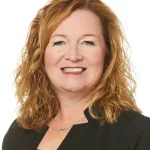 Senior Leader with diverse expertise in Not for Profit, Heath, Human Services and Education in Calgary. Committed to public service and collaborating to solve complex social issues. I have demonstrated success in leading a large complex school board that required diplomacy, governance relations and strategic communication and influencing skills.
Senior Leader with diverse expertise in Not for Profit, Heath, Human Services and Education in Calgary. Committed to public service and collaborating to solve complex social issues. I have demonstrated success in leading a large complex school board that required diplomacy, governance relations and strategic communication and influencing skills.
I am passionate about advocating for the things that matter most to me, access to healthcare, a strong public education system, and a strong social sector that is focused on the wellness of all. I am not keen on the status quo and love connecting with others who feel the same.

